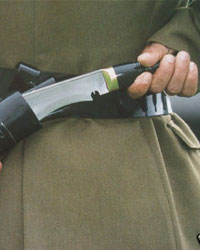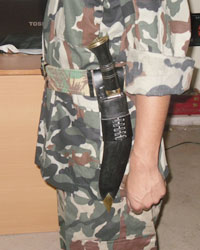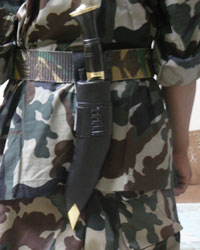Taking care of your khukuri, sword, machete, knife & other blades:
First we would like to clear that all our blades are made to last a life time. But despite this, like all things made from steel, our khukuris, swords, machetes, knives, axe, hatchets, tomahawks and all other blades can corrode and rust over time. So, a few minor steps to take care of your blade goes a long way to ensure that it really lasts a life time. If you follow these few steps to take care of your blades then one day we will not be surprised to hear your children or grand children inheriting your blades and being able to use them as well as you did. Please follow these steps to take care of your blades to ensure their long life. In the steps below when we mean blade we normally mean the entire blade from the bottom of the handle to the tip of the blade itself.

- Clean the blade: Before storing the sword, make sure it is clean and free of any debris, dirt, or moisture. Use a soft cloth or paper towel to wipe down the blade and remove any dirt or moisture from it
- Apply protective oil: Apply a thin coat of protective oil to the blade to prevent rust and corrosion. You can use many types of oil like mineral (engine) oil, ballistol, gun oil or specialized sword oil for this. Just make sure to use an oil that does not contain any harsh chemicals or additives. Be sure to cover the entire blade, including the tang and the hilt. Use a clean cloth to apply the oil evenly to the blade, and make sure to wipe off any excess oil
- Use a proper storage container: While the scabbard or sheath provided with the blade is good for storing & keeping your blade safe & protected for short duration (up to a few weeks at a time), we don’t recommend storing your blade on the provided sheath or scabbard for a long stretch of time. This is because the leather sheath scabbard with their leather enclosing may trap moisture over time which only enhances corrosion of the steel blade. So, choose a storage container that is specifically designed for your blade, such as a wooden box or case, a PVC tube, or a even a gun safe. Make sure the container is clean and dry, and line it with soft material to cushion and protect your blade for long term storage. Also make sure the blade doesn’t touch other metallic devices or surfaces.
- Avoid exposure to moisture: Keep the sword in a dry, cool place that is free from exposure to humidity, moisture, or direct sunlight. Avoid storing the sword in an area where temperature or humidity fluctuations are common, such as a basement or attic.
- Check the blade periodically: Even if the sword is properly stored, it is important to periodically check on it to make sure there are no signs of rust, corrosion, or damage. Remove the sword from its container and inspect it for any signs of rust, discoloration, or damage. If any issues are found, address them immediately to prevent further damage.
- Sharpening the blade: The blunt knife (Chakmak, provided with most khukuris) can be used for honing the blade. But we recommend using a file to sharpen a blade with significant damage or more dull edge.
Taking care of your sheath & scabbard:
- You should use shoe polish for the leather sheaths, use the brass polish for brass fittings and silver polish for silver fittings on Kothimora Khukuris.
- When storing your Khukuri for long periods. Keep the sheath separate from the blade. This will prevent the collection of moisture inside the sheath. Treat the scabbard with mink oil or another suitable leather treatment / maintenance product. This will keep your sheath leather conditioned and protected against moisture.
- If your scabbard or sheath gets wet or soaked in rain, first clean & wipe away water or moisture with soft dry tissue or cloth. Then let it dry at ambient temperature away from direct sunlight or radiator.
What we do before shipping your blade:
We normally apply a mix coat of grease and engine oil on the blade to prevent any corrosion during shipping. A blade when normally applied with such coating before storage can prevent it from developing rust for up to six months. After this you need to check periodically (every 5-6 months) for rusting and re-apply such coating if necessary.






